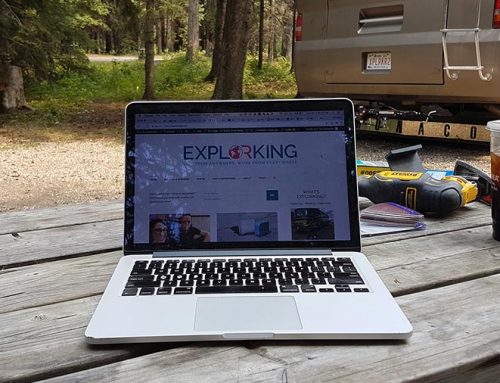We recently shared our 4 ways we generate revenue online and now we’re going to touch on the opposite of revenue, the dreaded “C” word… cost.
Cost doesn’t need to scare you. If kept in check, running your own business and being a badass entrepreneur shouldn’t set you back… if you do it right!
Costs can quickly spiral out of control. And if costs outweigh revenue, you may start relying on your personal savings or credit card to “bridge the gap until your next break”. This activity could end you in a pickle.
I (Kevin) have been fortunate enough to be in charge of a few multi-million dollar ventures, with capital provided by shareholders, coupled with pressure from public markets, stakeholders, and employees. Trust me when I tell you, sticking to spending what you earn is a good approach to business. This is especially true when the only capital you have to rely on is your own.
When we setup Healthful Pursuit, a business that now generates over a million page views, we were conscious of our costs and never once dug into our personal savings, credit cards, or line of credit in order to push the needle forward. If we didn’t have the money upfront, the project we were working on didn’t happen. We didn’t have the luxury of extra cash, so we made things work without it. Setting up our business with the culture of, “you only spend what you make” has stuck with us since the beginning (2010) and is still going strong. We will never spend more than we make. And if the going gets tough, we’ll downsize quickly, knowing we can build back up again when the time is right.
The trick, we’ve learned, is doing as much of the stuff as possible as opposed to spending money for other people to do it. Some of the benefits to doing things on your own instead of paying other people to do it for you:
- Save money
- Understand how the business works
- Knowing that it’s being done right
This way, when you do hire someone to help you out, you’ll know how it needs to get done, how long it should take, and you can set CLEAR expectations on what’s needed.
We could write about the cost of running an online business for days, and if you stick around, join our email list, and come back again and again, we probably will. But this post is meant as a lightweight introduction to the potential costs of running your online business so that you’ll be in the know when you start to make bank!
Let’s get started…
Staffing
The biggest cost to our business and other businesses I’ve been involved in is staffing costs. Whether you choose to go the employee or contractor route, full-time, part-time, or keep them on retainer (retainer is where you pay a fee for a certain amount of hours ahead of time and the contractor works to fulfill those hours during the set period. The problem with retainer is that you need to do it with a person you trust otherwise they can just take off with your money and if you don’t give them enough work, you’ll be paying for work that was never done. They get the retainer regardless of how little they work, so it’s good to be as accurate as possible with the retainer).
We’ve learned that it’s easy to hire, harder to fix bad hires, and very hard to find the right people.
TIPS!
- Hire for the $5, $100, and even $1,000 tasks. If there are things you do in a day that generates $5, $100 or even $1,000 for your business, hire someone to do these things. You need to focus on the BIG picture items, the $10,000 or even $100,000 ideas.
- Take your time hiring.
- If it’s not a good fit, make a change as soon as you can.
- Watch the cost of staffing.
- Hiring freelancers can be hit-and-miss, but we’ve found some of our best people on sites like Freelancer.
Tools
Our garage, until recently, was filled with tools: saws, drills, clamps, it was a hot mess (at least that’s what Leanne called it… let’s go with organized caos).
It’s easy to get distracted by “the next best tool that’ll revolutionize your business” and end up spending a lot of money on things you don’t need.
TIPS!
- Be mindful of the tools you’re using to run your business and their resulting subscription charges.
- Only get what you absolutely need.
Our preferred tools include:
- Buffer for scheduling social media shares.
- SEMRush for search engine optimization.
- Adobe software like Photoshop, Illustrator, InDesign, and Lightroom.
We also have a number of premium plugins and extensions for WordPress that could be categorized as a tool.
Services
We also pay for quite a few services. These are similar to tools but are more automated. For example, we use a newsletter mailing service to deliver newsletters to our readers using a service called AWeber and pay for consulting services for things like SEO (search engine optimization).
It’s important you understand what you are paying for, set clear expectations of how it’s going to help your business, and manage your expectations. If a service is not working out, and you feel like you’ve exhausted all options, change it up.
Hosting
Pretty much any business has a website and, websites require web hosting. Thankfully, there are many web hosting solutions out there. And, it may surprise you with just how cheap hosting is but how expensive it can get when more and more people come to your site. As you grow, the quality of hosting matters. If your site is hosted with a bad host, you’ll have site downtime issues, and a whole whack of problems you don’t want to deal with.
Using BlueHost is a great option for getting started.
I wasn’t kidding when I wrote that we could spend days about cost management, but this should give you some food for thought. The most important thing when it comes to cost is to only pay for what you need and grow into it. You’ll likely be far better off setting things up like that.
Have fun!






Wow!! All I can say is: !WOW! Thanks so much, Kevin for this timely, informative read!!! You and LeAnne are the bomb!! I follow your blogs religiously and gain such wonderful insight from you both!! Have a great summer! You guys are the best!
Wow, we’re honored by your lovely comment, Sheila! Thanks for following along. We can’t wait to share even MORE with you!
Great jnfo! I have been struggling with the idea of doing an online business, blog, meetup groups with webinars for real estate investment targeted specifically for certain professional groups in about 20 key states of interest. I would to do what you guys are doing by purchasing a motor home to tour the country. Double duty, travel and work from my laptop and phone from anywhere at any time. Seeing what you two are doing tells me it’s definitely possible. I’m strongly considering keto diet and intermittent fasting for weight loss and overally healthy lifestyle changes to cure my mind and body. Is it hard to on the road all the time?